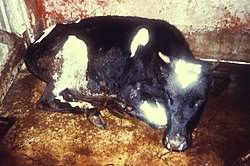Rinderpest:

India has secured a prestigious position in global animal health with the designation of the ICAR-National Institute of High Security Animal Diseases (NIHSAD) in Bhopal as a Category A Rinderpest Holding Facility (RHF).
- Rinderpestis also known as cattle plague, is a contagious viral disease affecting cloven hoofed animals (mainly cattle and buffalo).
- It is caused by a virus of the Paramyxoviridae family, genus Morbillivirus.
- Many species of wild and domestic cloven-hoofed animals (including sheep and goats) show only mild symptoms of the disease when infected, but for cattle and buffalo, mortality rates can reach up to 100 percent in highly susceptible herds.
- Other than cattle and buffalo, rinderpest can infect zebus, water buffaloes, African buffaloes, eland, kudu, wildebeest, various antelopes, bushpigs, warthogs, giraffes.
- It is spread by effective contact between animals carrying the virus and susceptible animals. The virus is found in nasal secretions a few days before any clinical signs appear.
- As the disease progresses the virus is found in most body fluids and either death ensues, or the animal recovers, develops immunity and clears the virus from the body.
- In cattle, signs of the disease include fever, erosive lesions in the mouth, discharge from the nose and eyes, profuse diarrhoea and dehydration, often leading to death within 10 to 15 days.
- In other species rinderpest may show milder clinical signs.
- There is no public health risk, since rinderpest does not affect people.
- It historically occurred in Europe, Africa and Asia.




